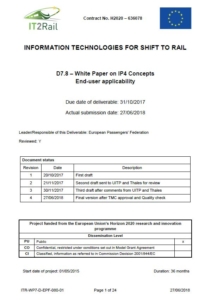 The European Passengers’ Federation’s White Paper on IP4 concepts End-user applicability is now available for download. EPF has published this White Paper in the framework of the IT2Rail project, which has now finished and has organised its final conference in Vienna on April 18th @TRA.
The European Passengers’ Federation’s White Paper on IP4 concepts End-user applicability is now available for download. EPF has published this White Paper in the framework of the IT2Rail project, which has now finished and has organised its final conference in Vienna on April 18th @TRA.
IT2Rail is a first step towards achieving the objectives of IP4 (IT solutions for Attractive Railway Services), one of the Shift2Rail Joint Undertaking’s long-term Innovation Programmes. Within IP4, the objective is to create a seamless multimodal travel experience by providing travellers with smart personalised services to facilitate each stage of the journey:
- Travel shopping (dealing with planning & pricing)
- Booking & Ticketing (dealing with booking, payment, ticketing and validation)
- Trip Tracker (dealing with tracking & re-accommodation)
- Business Analytics (dealing – amongst other things – with post-sales & settlement).
The traveller can access these services through their ‘Travel Companion’, which functions as a ‘front end’ user interface. In the ‘back end’, the Interoperability Framework guarantees technical interoperability of multimodal services by insulating consumer applications from the task of locating, harmonising and understanding an open-ended world of data, events and service resources, which are consequently made available ‘as a service’.
Travellers do not interact directly with the Interoperability Framework (IF) or its assets. That is why in thisWhite Paper on IP4 Concepts End-user applicability, the focus is not on the Interoperability Framework as such but rather on the different functionalities developed within IT2Rail based on the IF. For each of these components, the added value is discussed, as well as suggestions for further developments/improvements from the point of view of the end-user: the traveller.
The main advantage of the Travel Companion approach is that it simplifies life for the traveller by shielding them from the underlying complexity of different, non-integrated, fragmented information, payment, ticketing, validation etc. systems and procedures and acts as an all-encompassing user ‘front end’ interface giving access to a large number of multimodal products and services. IT2Rail focuses on a number of concrete use cases – specific instances of an individual traveller’s journey – that follow the traveller throughout the different stages of planning, booking and executing a multimodal journey, in order to better understand actual user needs along the way. The use case approach is important because the traveller is placed at the centre of innovative solutions.
This White Paper formulates general recommendations that should be taken into account in the follow-up of IT2Rail, i.e. other Shift2Rail IP4 projects, as they may ensure a better market uptake.
In the main, the results achieved in IT2Rail are promising. However, an important limitation from a traveller’s point of view is that currently, the IT2Rail use cases tackle only co-modal combinations of major transport modes. Further developments that introduce additional use cases and intermodal through-ticketing possibilities, covering also a wide variety of first and last mile solutions are welcome. Regarding passenger rights, the European Commission is currently examining options to better protect passengers in the EU when using multimodal transport. The outcome of this process should also be taken into account. Finally, the involvement of the end-users, the passengers, is key in follow-up projects. The IT2Rail Travel Companion and its components are meant to cater to various user groups which may have different needs and expectations about its functionalities. Travellers should be actively engaged in subsequent IP4 projects and called upon to actually test and evaluate the products and services that are being developed.


 Stay informed!
Stay informed!